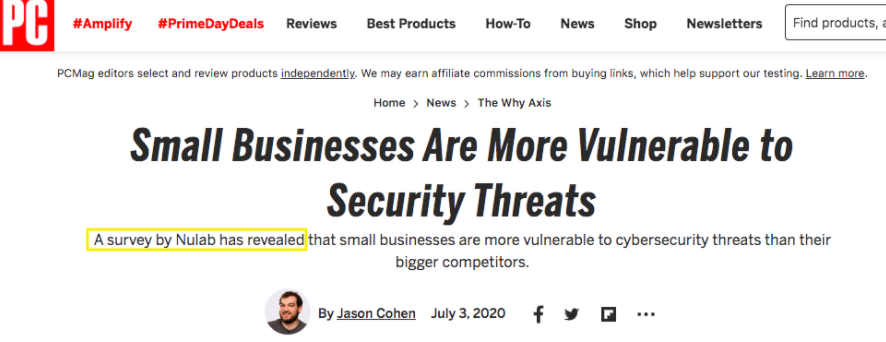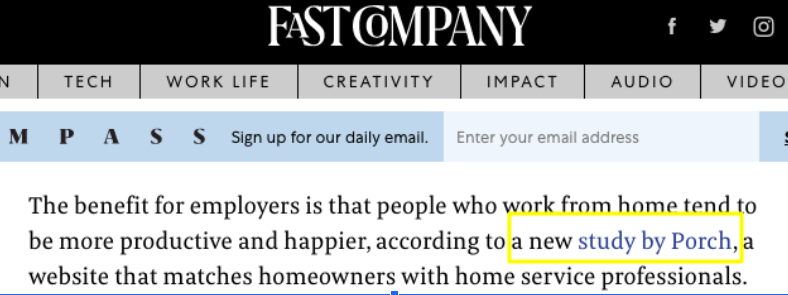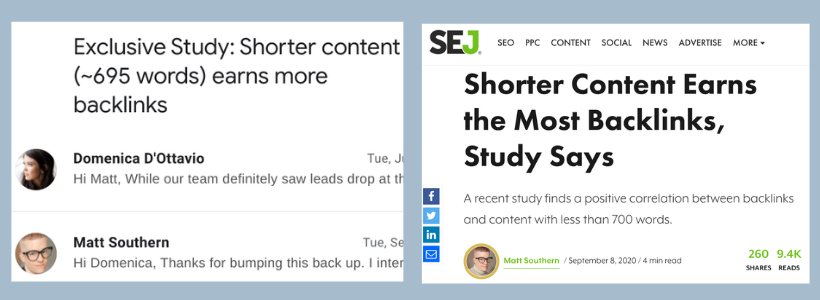It’s every marketer’s ultimate dream to get their name and product out there in the public eye. It’s why brands will pay millions of dollars for a 30-second Super Bowl commercial and why social ad spending hit $36 million in 2019.
But there’s another way to get people talking about your brand that won’t cost you millions of dollars. In fact, in many cases, it comes at absolutely no cost to you.
Think it’s too good to be true? Think again. Earned media is taking center stage instead of paid tactics because of its effectiveness in boosting your brand recognition, authority, and your ranking on Google search.
What is Earned Media?
{{cta(‘0ffa6b45-1cad-4970-96fd-eeda9cbdc06c’)}}
Earned media, in the most simple definition, is publicity. Free publicity, that is. This is not sponsored content (in which you pay to be featured in an online news story), nor is it social media engagement that you pay for using boosted Tweets or Facebook posts. Earned media can take different forms, including:
- Natural social media buzz around your brand
- Unpaid reviews about your products
- Press mentions and online articles featuring your brand
While these different types of earned media all support building brand awareness, positive sentiment, and authority, the last point is the most sustainable and significant type of earned media, and it’s what I’m going to be focusing on in this article.
How Does Earned Media Fit into the Objectives of Digital PR?

You may have heard of the PESO model; a structure put together by Gini Dietrich of Spin Sucks, which includes all of the components of different types of media marketers work with. Here’s a quick recap of what the PESO model represents:
- P stands for paid. This is any media you pay for, including email marketing, sponsored posts, social media ads, and any other pay-per-click (PPC) tactics.
- S stands for shared. In other words, social media. This includes social networking, online communities, partnerships, and social promotion.
- O stands for owned. Owned is the content that lives on your website, , which can be anything from blog posts to testimonials.
- And that leaves E for earned. Earned media is publicity, like getting your brand mentioned in an online news outlet.
The fantastic thing about the PESO model is that in 2020, none of these activities exist in a vacuum. If you want to reap the most benefits from your content, you should integrate a few tactics together.
For example, you can combine three of the tactics above by creating a piece of content on your blog (owned), promoting that content to news outlets (earned), and sharing it on social media (shared).
While each of these tactics has its benefits, earned media is extremely powerful in establishing brand authority and benefitting your SEO efforts.
What Are the Benefits of Earned Media?
While it can be challenging to execute in the beginning stages, earned media’s benefits far outweigh the setbacks that arise from implementing it for the first time. Unlike paid, earned media will only cost you your time, and the results will have you coming back for more. Successful earned media will boost your brand awareness, authority, reputation and improve search engine rankings.
Boost Your Brand Awareness
Creating content and promoting it to high-authority media publishers will get the conversation rolling about your brand. When you’re featured on large media outlets, new customers will find you for the first time.
Increase Your Credibility and Authority
When you get your content featured on an online news publisher, future customers will associate the news outlet’s high-authority with your brand. They trust the site where they consume their content, and so they will begin to trust your brand, too.
Look at these examples of how our clients have been mentioned in major news publications:
Shape Your Brand Reputation
Earning media coverage from top-tier publishers will give you the chance to shape how you’re talked about online. You can create the content that will put your brand in a strategic position, and then the stories that are written about your content will reflect on your brand.
Increase and Improve Search Engine Rankings
One of the most important benefits of earned media is its influence on search engine rankings and how quickly people find you via Google search. When your content is featured on reputable online publishers like the Washington Post and CNBC, they will link back to your site. This informs Google that your site is valuable and you’re trustworthy, and it will likely increase your position on the SERPs.
How to Build an Earned Media Strategy
It is generally recognized that there are three main ways for marketers to achieve earned media:
- Creating content worth sharing
- Interacting with your audience on social media and engaging via hashtags
- Going above and beyond for your customers
The last two points have to do with how you do business with your customers directly. When you provide top-tier customer service and interact thoughtfully with your audience on social media, you’re turning customers into fans. In turn, they will talk about you for free on social media and leave 5-star reviews, all of which boost your brand’s reputation and presence online.
However, the first point is crucial to any long-term earned media strategy because it can significantly boost your search rankings and bolster your brand’s awareness, making it easier to both find and trust your brand.
There are several different tactics you can use to achieve online news coverage for your brand. Some methods include:
Pitching “Best of” Lists
There are many “Best of” lists online: best content marketing podcasts, best toothpaste brands — whatever you do, there’s probably a list for it. Find out the author of the post and send them an email asking to be featured.
Asking to Guest Post
Guest posting is a great way to build a personal brand and contribute to industry conversations online. Guest posting can be tricky, so be sure to read our guide on guest posting before you get started.
Responding to HARO Requests
You can sign up for HARO, or “Help a Reporter Out,” and monitor any journalist requests that correspond to your content vertical. Often, journalists will ask for expert quotes or products that fulfill a certain need. HARO sends out a list of queries daily.
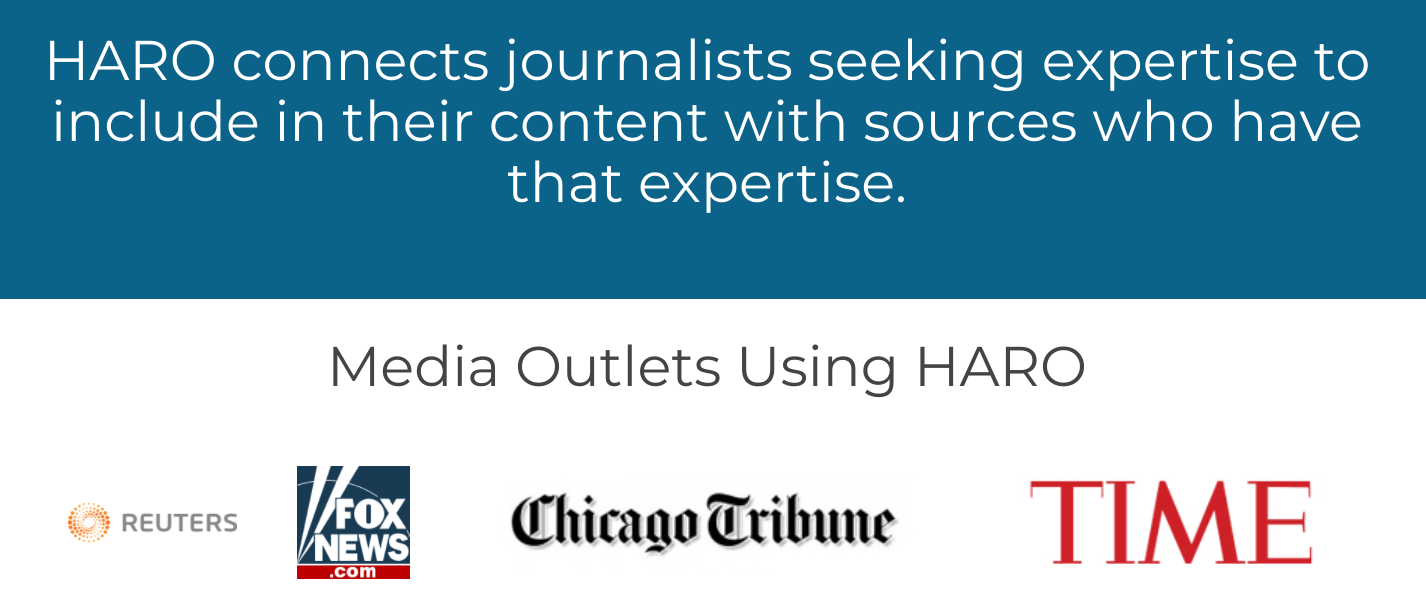
Sending Products for Review
Another great way to get coverage from online publishers is to send their product review team or relevant influencers some of your products to test out. There’s no guarantee that they’ll like it or write positively about it, but it’s how many new companies first get shared online.
Pairing Data-Driven Content with Highly Strategic Digital PR
This last tactic is Fractl’s bread and butter. When we say “earned media,” this is what we think of. This strategy requires far more effort than any other earned media tactics, but the benefits reaped are tenfold.
Fractl’s Tried and True Earned Media Process
Fractl’s been at the earned media game for about eight years, and after producing and promoting thousands of earned media content campaigns, we know what works. Our process of achieving high-authority backlinks on top tier news outlets can vary from client to client, but in general, it looks something like this:
- Ideation
- Production
- Promotion
- Reporting
Ideation: How to Come up with Share-Worthy Content Ideas
Every day at Fractl, we come up with hundreds of ideas for a dozen different clients across every topic vertical: tech, health, food, sex, sports, and more. But still, we throw away 80% of our content ideas.
All of our ideas have to be evaluated through our SUCCESs model: ideas have to be simple, unexpected, concrete, credible, and emotional for them to pass through the vetting stage.
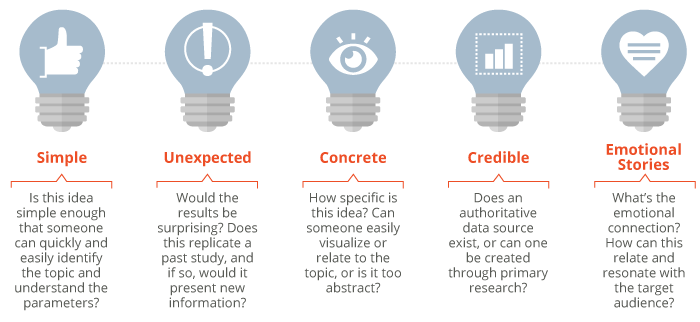
One of the most essential tenets of the SUCCESs model is Emotional. If the idea does not generate an emotional response from the reader, they aren’t likely to hit share. If the story isn’t relatable or does not incite anger, love, or sadness, the journalists won’t want to cover the project, and your campaign won’t get very far.
What Are Your Goals for the Content Piece?
The ideas you ultimately end up choosing will also depend on the goals you have set out for the content. You’ll want to work backward from what you want to achieve and develop ideas to work towards those goals.
Examples of goals include building high-quality backlinks, increasing your general brand awareness, increasing your brand’s awareness in more industry-focused publications, building your organic traffic, increasing your brand’s authority, and more.
A great example of content that meets two goals (earning backlinks and building authority) is Birth Control Around the World, a project we produced on behalf of Superdrug Online Doctor, an online pharmacy in the U.K.
Did this idea pass the SUCCEs model?

- The idea was Simple: How is birth control used around the world?
- It had elements of Unexpectedness: The withdrawal method, despite being lower in effectiveness, dominates in many regions around the world.
- It is Concrete: The idea is specific and answers the question.
- It is Credible: The data used for the analysis are all reputable and comes from governmental or nonprofit sources.
- The idea has Emotional resonances: Whether you’re a man or woman, single or in a relationship, birth control and contraception is something that almost everyone needs to think about in their daily lives.
Producing an Earned Media Campaign
Going from an idea to a finished product isn’t always straightforward. When we make content campaigns, we have to ask ourselves: What is the best way to execute this idea?
There are several ways to compile data on any given topic. Some methods include:
- Surveying respondents
- Using publicly available data
- Germ swabbing
- Utilizing clients’ internal data
- Running real-life experiments
- Scraping social media
For the contraception around the world example above, using publicly available data made the most sense because sourcing data from official health organizations is more accurate and has more credibility than running a survey or scraping social media for insights on that particular topic.
What we produced was informative, sparked conversation, and was directly linked to a product on the site.
Using publicly available data from the CDC, the NHS, and WHO, we sought to educate our audience on the prevalence of contraceptive methods worldwide. Despite this data being available for the public, these large data sets are often not easily accessible or understandable for the average person.
We compiled and analyzed the raw data to create visually appealing charts and graphs that can be understood at a glance. Creating visualizations and infographics is an integral part of creating off-site content primed for digital PR coverage because journalists love to share relevant images in their online articles.
Journalists and editors at online publishers are busy. If you can communicate the essence of a story in a single graphic, they’re more likely to cover your pitch than if they have to spend time reading pages of copy.
Once the graphic data visualizations are designed, the copy is written, and the study is published, and digital PR campaign promotion can begin.
Merging Owned and Earned Media
You know from the PESO model that owned media is any content that appears on your website or blog. In a sense, all of the content we create for digital public relations campaigns can be considered owned, especially if they are optimized for Google (SERP rankings, organic traffic, and potentially natural links).
However, the real benefit of this type of content can be achieved through digital PR tactics, and so it also falls under the umbrella of earned.
How to Promote an Earned Media Content Campaign with Digital PR
Promotion can be one of the most challenging parts of this process. After sending a hundred pitches and receiving no replies, you might want to throw in the towel on earned media. But, before you do, consider that you might be going about pitching the wrong way.
Read on to learn more about how to pitch a journalist to achieve top-tier media coverage properly.
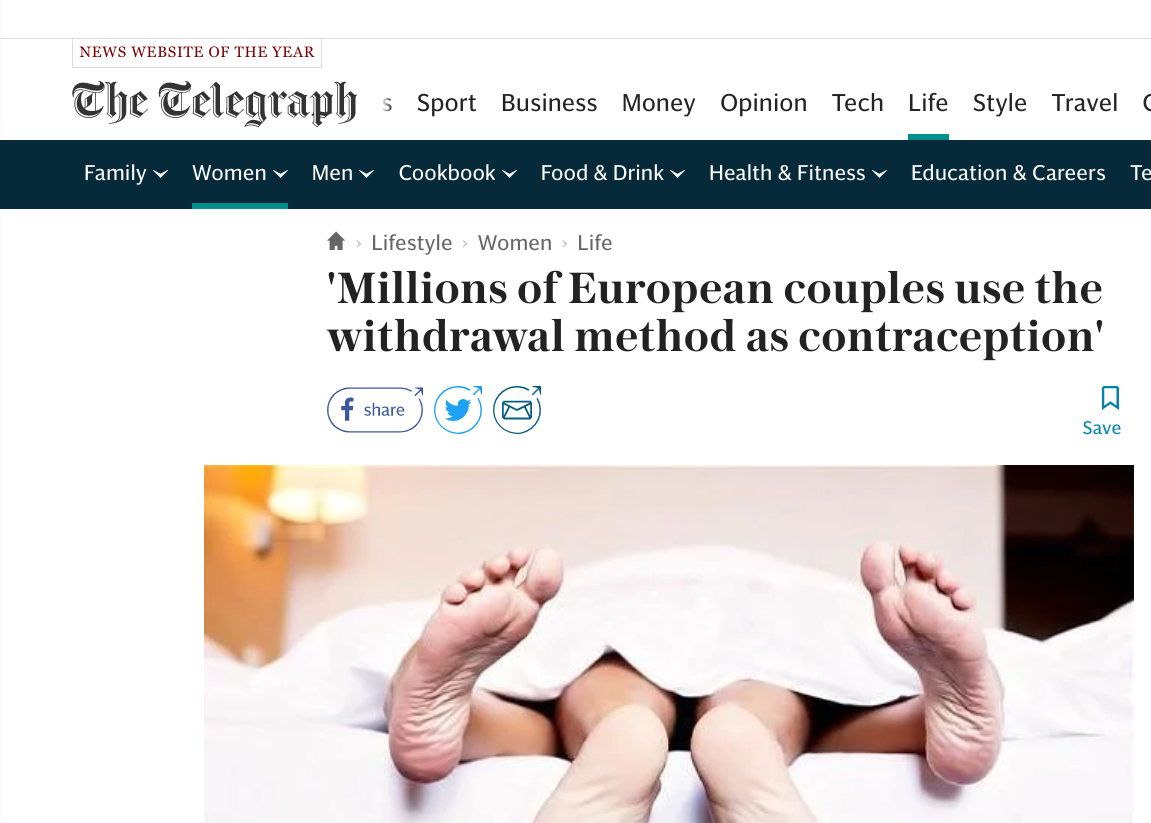
Identify Key Insights
The first step for promoting any content you produce is to sit down and consume that content thoroughly. Note anything of interest, anything that surprises you, and the key takeaways of the content. What angles can you identify? Envision headlines that could be formed based on the content. Picture what journalists would find interesting about the content.
List Build
Once you understand the content backward and forwards, start building your media list. Come up with at least 20 different journalists at different high-authority online websites that frequently cover your content topic and have recently written about that topic.
Focus on top-tier publishers first, and once you get the first piece of coverage (called the exclusive), start list building for lower-tier sites that still provide value in your niche.
Write an Effective Pitch
The media pitch is one of the most talked-about aspects of digital PR, and for good reason. It’s the most essential part of content outreach and the one that journalists lament about the most online.
Fractl has done tons of research on this topic, and we encourage you to check out our latest research: the 2019 publisher survey.
We surveyed over 500+ journalists, editors, and bloggers who write for top-tier publishers to find out what they look for in content and in PR pitches. Here’s what we found:
- Most writers (58%) prefer to receive a pitch between 100 and 200 words.
- Our data shows that journalists prefer 0 or 1 follow up emails an average of 3 to 7 days after you’ve sent your initial pitch.
- 50% of journalists receive fewer than 10 pitches a day. Just over 42% of writers reported receiving 11 to 100 pitches a day, and almost 5% receive 100+ email pitches per day.
- Our data shows that journalists prefer 0 or 1 follow up emails an average of 3 to 7 days after you’ve sent your initial pitch.
- Over 53% of writers say they don’t subscribe to press release sources.
You can quickly review the TOp ten journalist pet peeves in the graphic below.
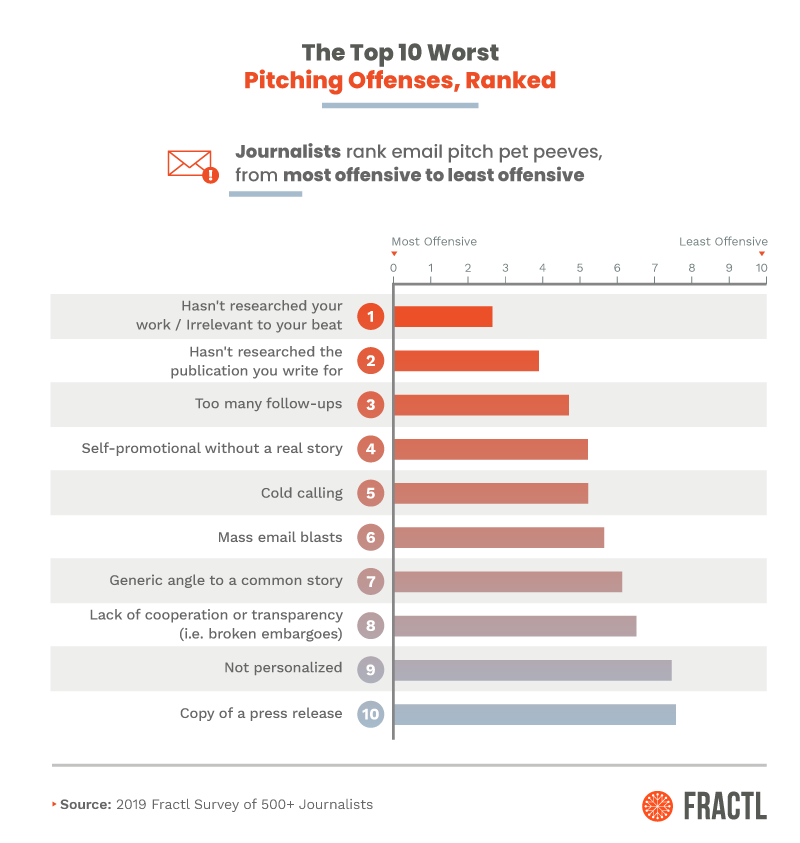
How to Measure Earned Media
Measuring your digital PR content campaign’s effectiveness can be challenging, but there are tangible metrics you can use to gauge whether your campaign was a success.
Brand Coverage
The most tangible way to measure success for digital PR campaigns is to review all of the reputable websites your content was featured in.
For a client based in the U.K., the initial placements resulting from outreach were precisely the types of sites their potential clients are spending time on — websites like the Telegraph, the Sun, Huffington Post U.K., and Independent.ie.
Links
Another way earned media provides value is by linking back to your website.
Throughout digital outreach, the example we featured above (Contraception Around the World) earned 75 press mentions, 17 of which had dofollow links.
You can identify the links back to your site using tools like BuzzSumo or merely monitoring your brand on Google Alerts. Once you see the coverage, view the source code for the page to determine whether they linked to you and if they used nofollow or dofollow.
Also consider the authority and relevance of the link, as well as the placement of that link on the page.
Social Sharing
An unexpected way that earned media can provide value to your brand is by increasing social media mentions. It’s natural that when a publisher covers a story, readers who find it interesting, surprising, or emotional in some way will hit “share” and post it on their timeline.
These social media mentions are valuable because they contribute to brand awareness and expose you to new audiences.
Content Marketing is a Marathon, Not a Sprint
{{cta(‘8aa1518b-a12a-4da1-9492-7120937b9f8d’)}}
It is said that content marketing is a marathon and not a sprint. It usually takes at least six months to a year before you get the overall growth you’re looking for.
Content marketing, like a successful investment, has compounding returns that add up in time. The more high-quality, strategic content you make, the higher the returns will be.
Success for any content campaign is multifactorial. It can be hard to define a goal for a specific number of dofollow links or press mentions. Still, we’ve compiled a report on industry averages that can help you manage your expectations across any niche.
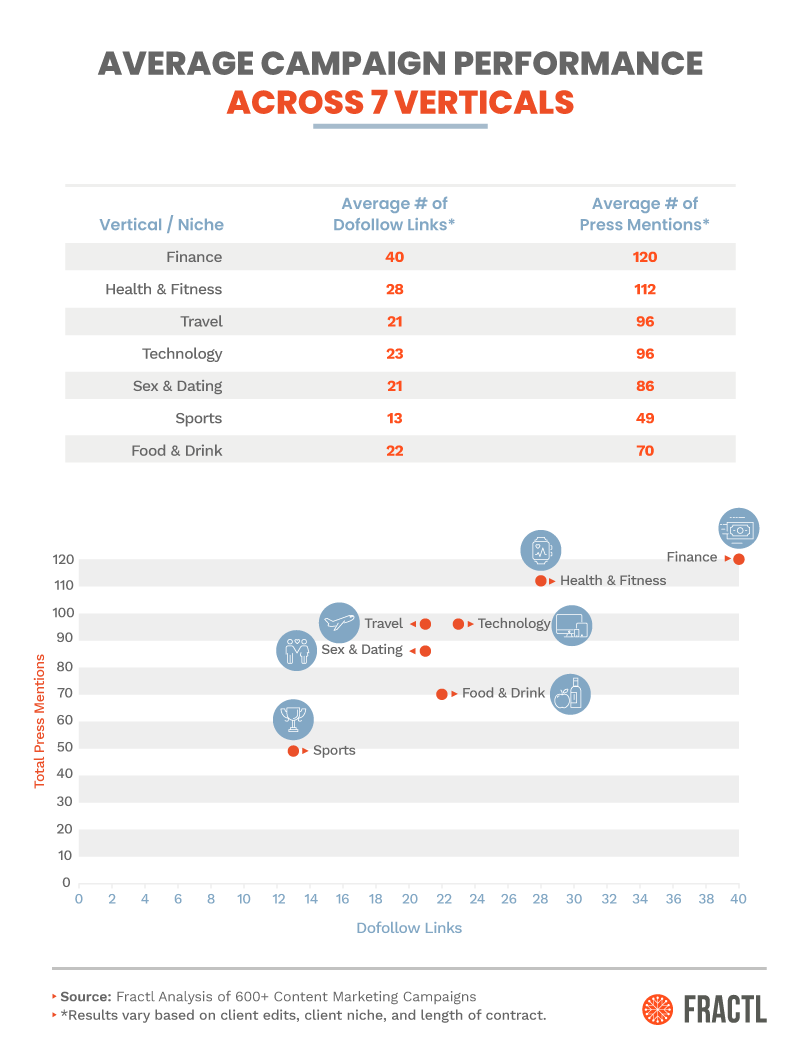
Start there, and remember: Building your brand’s awareness and authority by leveraging earned media will help uplift all of your other marketing efforts.
{{cta(‘f1500787-fa31-4f60-b8ae-28a2d28f67e6′,’justifycenter’)}}


